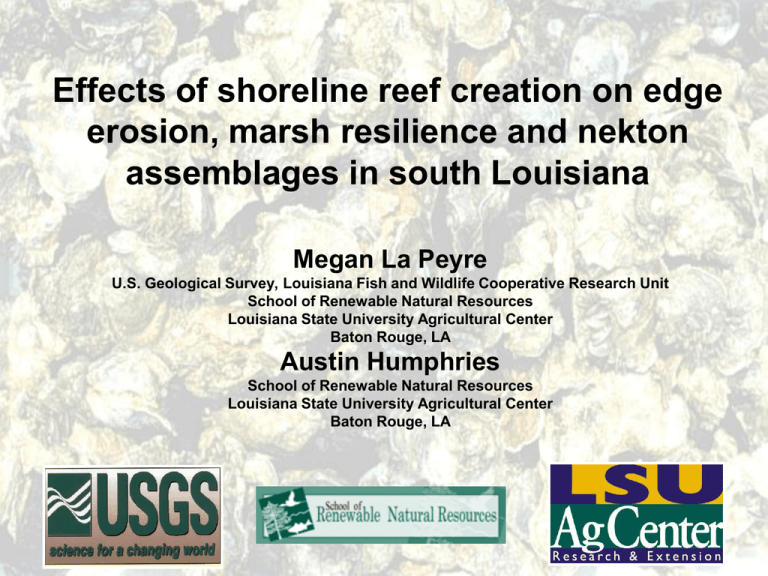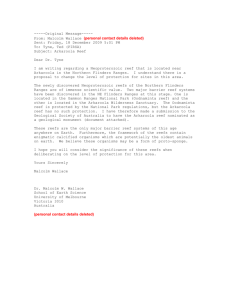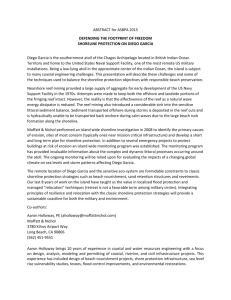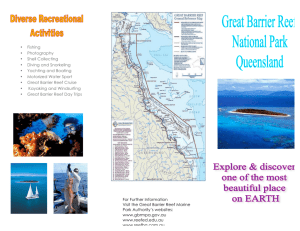La Peyre, M. - South Carolina Sea Grant Consortium
advertisement

Effects of shoreline reef creation on edge erosion, marsh resilience and nekton assemblages in south Louisiana Megan La Peyre U.S. Geological Survey, Louisiana Fish and Wildlife Cooperative Research Unit School of Renewable Natural Resources Louisiana State University Agricultural Center Baton Rouge, LA Austin Humphries School of Renewable Natural Resources Louisiana State University Agricultural Center Baton Rouge, LA Wetland loss 64 – 91 km2 y-1 25% of nation’s total fishery production in lower 48 Photo by Tyrone Turner – National Geographic > 500 projects Louisiana’s 2007 Master Plan: 1) hydrologic restoration 2) shore protection Shore Protection Tires, Wooden Structures, Christmas trees, Concrete Limestone rock - costly ($1 million / mile) - heavy (sink) - imported from out-of-state Oyster reefs - native - sustainable - potential added ecosystem benefits research objectives: examine effects of created reef size, shoreline orientation, and location on: 1. shoreline erosion 2. nekton (fish and decapod crustaceans) use 3. reef sustainability/oyster populations (Casas poster) North West Sister Lake South Gulf of Mexico “low” energy shorelines “medium” energy shorelines reef establishment: march 2009 Cost: < $300,000/linear mile “narrow” = 25 m x 1 m x 1 m “wide” = 25 m x 2 m x 1 m approach Measured quarterly: • Shoreline position • Soil characteristics • Vegetation • Nekton use % species composition marsh vegetation community 100% S. americanus 80% J. roemerianus S. patens 60% S. alterniflora D. spicata 40% B. maritimus 20% 0% north west south Similar production at all sites: 805.9 ± 74.0 g m-2 marsh soil properties % soil organic matter 35 A 25 15 B B north west 5 south Universal soil loss equation: increase OM 1-3%, reduces erosion 20-33% shoreline change Narrow Reef A Shoreline retreat (cm d-1) 0.6 **site interaction Wide Reef Reference AB AB 0.4 B B 0.2 0 Medium Energy Environment Low Shoreline retreat (cm d-1) 0.8 April 2009-August 2010 Narrow Reef Wide Reef Reference 0.6 0.4 0.2 0 North West South Medium Energy Gulf of Mexico shoreline effects - sites experienced extremely high erosion (1-3 m/18 mo) - at low energy sites reefs failed to reduce retreat - at medium energy sites, site-specific effects Restoration implications: 1) Need to understand local site environment, such as currents, morphology, bathymetry 2) Understand local weather patterns and in particular, dominant storm passages Gillnet sampling nekton Seine shoreline reef Quarterly: March, June, August, December 2009, 2010 Trays CPUE 250 West 200 North transient species South 150 100 50 0 Spring Summer Fall Winter 9.2 ± 0.4 5 8.6 ± 0.5 4 3Water quality: only difference between 1sites in salinity 12.4 ± 0.5 fall Season winter Gulf of Mexico Reef Mud 120 CPUE 100 Resident abundance 80 60 40 20 0 June Aug 2009 Dec March 2010 Does shell quantity impact resident abundance? 100 Adj r2 = 0.22 CPUE (# individuals/tray) 80 60 40 20 0 0 1 2 Tray shell volume (L) 3 4 Low High Four treatments Mud bottom Cage structure Cage plus low volume Cage plus high shell volume Mean abundance (# of indˉ²) b 30 b 25 20 abundance 15 10 a a 5 0 Mud Cage Low High Shannon diversity (H’) 3 b 2.5 b 2 1.5 b a diversity 1 0.5 0 Mud Cage Low High nekton support - transient abundance not affected by reef presence Restoration implications: - possible redundancy of marsh edge habitat 1) How do spatial location and adjacent habitats affect - residents more abundant and diverse at reef sites addedper value of reefs to factor transients - presence of structure se most important determining assemblages 2) Does added structure impact resident communities? 3) How might resident species, oyster population structure affect nekton communities? dead live Oyster density (m2) 6000 M-N = medium energy, narrow reef M-W = medium energy, wide reef L-N = low energy, narrow reef June 2010 3000 0 West POSTER: Casas et al. North South Frequency of size distribution (%) 100 September 2010 75 50 Spat: < 25 mm Seed: 25-50 mm Seed: 50-75 mm Commercial: >75 mm 25 0 West North South What are the key parameters to consider to identify the most viable shorelines for shore protection ? 1) local site conditions: energy, currents, morphology 2) oyster population response What factors influence the value of restored fringing reefs for resident or transient nekton? 1) characteristics of structure 2) functional response of nekton Experimental lab and field studies: - Location effects (shoreline, nekton, oyster populations) - Base material, size, design - Link oyster physiology, oyster population structure with nekton use - Foraging success with different structure Vermilion Bay Grand Isle, Breton Sound, Biloxi Marsh Sister Lake Funding Louisiana Department of Wildlife and Fisheries Collaborators Jerome La Peyre, Louisiana State University AgCenter Sandra Casas-Liste, Louisiana State University AgCenter Acknowledgments LA DWF – Heather Finley, Patrick Banks, Steve Hein, Willie Cheramie LSU – Shea Miller, Shannon Martin, Steve Beck, Ben Eberline, Anna Catalanello, John Gordon, Gary Decossas, Lainey Pitre, Matt Kimball Community - Wilson Voisin, Stephen Champagne, Antill Pipeline Construction Co.




